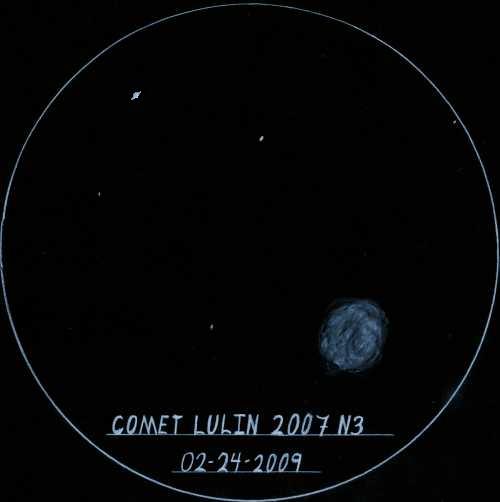Copyright 2008 Starry Mirror



The
TM
Astronomy From West Virginia
COMET LULIN C/2007 N3 MOVES INTO THE EVENING SKIES
BRIDGEPORT, WV (S-M) - We have been following Comet Lulin, C/2007 N3, recently. The comet is moving rapidly into the evening skies, and it crossed Leo from east to west in just the past week. The comet is very large and is easily visible in binoculars as a large hazy patch of light.
The comet has been visible for months but it was located rather low in the south, and it did not get high enough to be seen above our gum tree until mid-February. The first time we saw it, we were surprised by its large size. Looking with 80mm binoculars, the comet appeared nearly the diameter of a full Moon, and it was bright enough that it could not be missed. We have heard from others that multiple tails have been seen, but from our light polluted location, it appears that this is another comet which will always appear to have no tail. Still, the comet is bright and easy to find at around magnitude 6.
The comet made its closest approach to the Sun in mid-January, when it was still about 20 million miles more distant from our star than the Earth. It is making its closest pass by the Earth this last week of February, but it is still about 35 million miles from us. In fact, the appearance is comparable to how Comet Hyakutake looked at the same distance back in 1996, weeks before its close pass by the Earth. Unfortunately, Comet Lulin won't come any closer, and once again we are shown that for most comets, proximity has more to do with a good showing than the object's true brightness.
The comet was discovered at the Lulin Sky Survey in China on July 17, 2007. Comet Lulin is in an orbit which is almost exactly parabolic, so it probably will never return to the Solar System. - GW

Just after midnight on the morning of February 24, Comet Lulin could be seen just south of Saturn and the star Sigma Leonis, using 80mm binoculars.